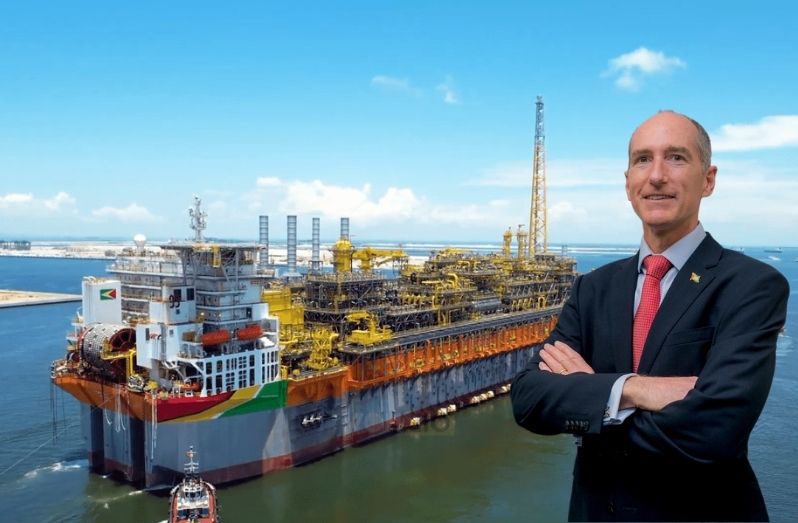–ExxonMobil prepares to shut down FPSOs for two weeks for connection, Routledge says
WITH the gas-to-shore pipeline project now 70 per cent complete, ExxonMobil Guyana is gearing up for temporary shutdown of two Floating Production Storage and Offloading (FPSO) vessels to connect the pipeline for the Gas-to-Energy Project.
The project will harnesses natural gas from the Stabroek Block, channelling it through a 200km pipeline to a new power plant and Natural Gas Liquids (NGL) facility at Wales.
During a press conference at the company’s Georgetown headquarters on Tuesday, ExxonMobil Guyana President Alistair Routledge spoke about the impending shutdowns to facilitate the connection of the pipeline.
Routledge said that by leveraging resources from the Liza Phases One and Two FPSO vessels, the project aims to enhance energy efficiency and sustainability across the nation.
With three FPSOs currently in operation, ExxonMobil is producing approximately 613,000 barrels of oil per day in the Stabroek Block, offshore Guyana.
However, as the Gas-to-Energy Project enters its critical phase, production is expected to temporarily decrease by over 160,000 barrels per day as the Liza Destiny and Liza Unity FPSOs undergo shutdowns for pipeline connection.
“We are on schedule to deliver the pipeline, and it should be ready to start up by the end of this year,” Routledge affirmed.
He said that the offshore portion of the pipeline is now 70 per cent complete, with two installation vessels deployed to expedite the process.
One vessel operates in shallow waters near the shore, while the other lays the pipe in deep waters, showcasing ExxonMobil’s commitment to efficiency and innovation.
Onshore, significant strides have been made, with construction progress reaching 68 per cent.
This holistic approach ensures that both offshore and onshore components of the pipeline project are advancing in tandem, laying the groundwork for a seamless transition to natural gas utilisation.
In February, the works were approximately 40 per cent completed and the offshore portion about 55 per cent finished.
Routledge also shed light on ExxonMobil’s proactive approach to early enabling works, which have played a crucial role in expediting project timelines.
Routledge said: “In the early days, we executed enabling works such as site clearing and road construction…this initiative has saved a lot of time on the front end of the project.”
By undertaking preparatory initiatives ahead of schedule, ExxonMobil has minimised potential delays and streamlined subsequent project phases.
“That initiative has actually saved a lot of time on the front end of the project by getting the early enabling works done,” he said.
Addressing concerns regarding the temporary shutdowns of FPSO vessels, Routledge highlighted the necessity to ensure the seamless integration of the gas pipeline.
“The Liza Destiny and Liza Unity FPSOs will be shut down independently in July and August,” he clarified.
Despite the anticipated production decreases during these shutdown periods, Routledge assured stakeholders of ExxonMobil’s commitment to minimising disruptions.
“Our estimates are roughly two weeks for each of those shutdowns. But we continue to refine the details of the shutdown order procedures making sure that we execute them safely.
“And then we’re able to execute the actual installation work and meet the objective of connecting the pipeline.
That work is under detailed. We’re anticipating, July- August shutdown,” he said.
Looking ahead, Routledge outlined ExxonMobil’s strategy for maintaining pipeline integrity until it is ready to transport natural gas to the power plant.
“Once the pipeline is constructed, we will ensure that it is kept secure…This involves measures such as leaving it with an inert gas-like nitrogen or treated water until it is ready to transport gas to the power plant,” he said.
Upon operationalisation, the pipeline will not only enhance energy infrastructure but also unlock new opportunities for economic growth and sustainability.
Routledge reiterated ExxonMobil’s commitment to delivering the project on schedule, noting: “We are all committed to ensuring that this project comes on stream as soon as possible.”
Despite facing temporary setbacks in the form of FPSO shutdowns, the project remains firmly on track, with progress exceeding expectations and a steadfast commitment to excellence.
The aim is to complete the necessary transmission lines and substations by the end of the year, ensuring a seamless distribution network along the Demerara Berbice Interconnected System (DBIS).
By providing a more reliable and cost-effective energy source, the initiative could drastically reduce the frequency and duration of power outages while also, as part of the energy, cutting the cost of electricity by almost 50 per cent.
Such improvements would not only enhance the quality of life for Guyanese but also foster a more conducive environment for business and industry growth.
ExxonMobil Guyana, along with partners Hess and CNOOC, through their subsidiary Esso Exploration and Production Guyana Limited (EEPGL), has provided an assurance to the government that a minimum of 50 million standard cubic feet of gas per day (mmscfd) will be transported via the pipeline by 2024.
The pipeline will be able to transport a maximum of 130 million standard cubic feet per day. The project offers the dual benefits of reducing energy costs and meeting the increasing electricity demand in Guyana.
Consultant for the Ministry of Natural Resources, Winston Brassington recently said that this initiative is poised to transform the energy landscape in Guyana, offering a sustainable and cost-effective alternative to the current energy mix.












